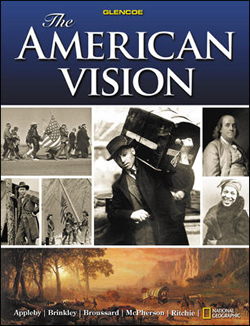
The American Vision © 2008Chapter 17: The Jazz AgeChapter OverviewsThis chapter follows the new social attitudes and cultural changes that defined the 1920s. Section 1 discusses the presidencies of Warren G. Harding and Calvin Coolidge. With a pledge to return the nation to normalcy, Harding won the presidential election of 1920. However, the Harding years proved to be far from normal. Scandals rocked the administration as some of the members of Harding's Ohio Gang accepted bribes, pocketed taxpayers1 money, and sold government jobs and pardons. When Harding died suddenly, Vice President Calvin Coolidge took the presidential oath. Reserved and frugal, Coolidge aligned himself with business and prosperity, and he calmly worked to restore the integrity of the presidency. In the 1924 presidential election, he easily defeated the Democratic and Progressive challengers. During the 1920s, Republicans in power cut spending and taxes and worked to help businesses. In its foreign relations, the government worked with its allies and worked to limit arms production. Section 2 describes the economic prosperity of the 1920s. During the 1920s, Americans enjoyed higher wages and more leisure time than ever before. New technologies, such as automobiles, airplanes, and radios, led to new industries, while new production methods increased output and lowered the prices of consumer goods. The economy was rolling, and Americans fueled the manufacturing boom by purchasing a flood of new goods. While advertising introduced new products, easily available credit encouraged consumer spending. The middle class rapidly grew as industries hired professional managers, and welfare capitalism helped industrial workers prosper. While the prosperity of the 1920s brought a better standard of living to many Americans, farmers struggled with debt and surplus crops. Section 3 explains how the 1920s saw clashes between Americans' traditional and modern values. In the early 1920s, economic recession, increased immigration, and racial and cultural tensions led to a general rise in nativism and racism. A pseudo-scientific belief reinforced nativism, and a new Ku Klux Klan targeted groups it considered "un-American." Many Americans who worried that immigration would threaten traditional social orders applauded new laws that limited immigration and heavily discriminated against certain groups. Other social changes swept through the nation during the 1920s. A new morality glorified youth and personal freedom, and women enjoyed new economic, social, and intellectual freedoms that were reflected in their fashions and behaviors. As Americans responded to what some saw as a decline of American morality, a new religious movement emerged, and interest in the temperance movement renewed. The Eighteenth Amendment and the Volstead Act made prohibition a federal cause, but public response to the laws ended up encouraging organized crime. Section 4 describes how the modern age of the 1920s strongly influenced American art, literature, and popular culture. During the 1920s, writers, artists, and intellectuals challenged traditional ideas as they searched for meaning in an industrialized world. Artists worked in a diverse range of styles, each trying to express the individual, modern experience. The works of many poets, playwrights, and novelists often had tragic underpinnings as they described the human experience with concise, realistic images. The 1920s offered many Americans more time and money to enjoy leisure activities. They eagerly attended movies and sporting events, participated in sports, and listened to radio broadcasts. Sports figures, movie stars, and aviators emerged as the new American heroes. During the 1920s, mass media not only helped broaden Americans' interests, but they also enhanced Americans' feelings of a shared national culture. Section 5 discusses how the African American voice found new expressions during the cultural renaissance of the 1920s. During the Great Migration, hundreds of thousands of African Americans escaped segregated Southern society and poured into the industrial cities of the North. One neighborhood in New York City stood out as the center of African American cultural rebirth and expression. The artists of the Harlem Renaissance expressed their frustrations and their dreams in an explosion of literary, musical, and theatrical works. Artistic achievements of the Harlem Renaissance reinforced racial pride and fueled interest in community and political involvement. African Americans found a political voice with the vote and in organizations such as the NAACP. While some worked to improve the political and economic positions of African Americans, other groups emphasized black pride and advocated African American separation from white society. |  |















